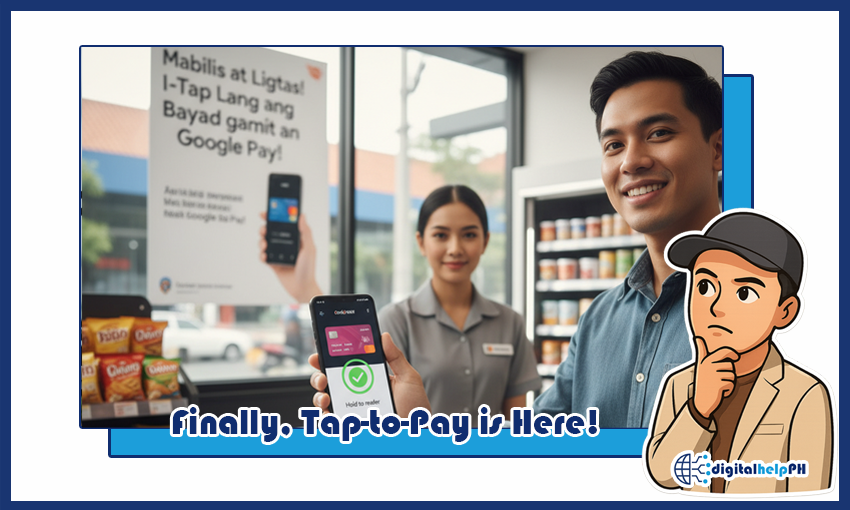Last Updated on September 29, 2025
The long wait is almost over, mga suki! After years of watching other countries tap their phones to pay, Google Pay (or Google Wallet) is officially launching in the Philippines. This is the biggest digital payment news since QR Ph, and it’s a game-changer for every Android user and mobile banking app.
Forget the hassle of bringing your physical card, the future of payment is a simple tap of your phone. But what does this mean for your current bank account? Which local banks are ready? And how can you start using this convenient ‘Tap-to-Pay’ feature right now?
Key Takeaways
- The Official Launch Date: Google Pay (Google Wallet) is reportedly rolling out in the Philippines starting November 18, 2025.
- Initial Compatibility: The phased launch will prioritize Mastercard credit and debit cardholders from major partner banks (e.g., BDO, BPI). Support for Visa will follow soon after.
- Local Pioneer: UnionBank has already launched its own native Mobile Tap-to-Pay feature for its Visa cards, giving many users a head start on the secure NFC payment experience.
- BSP’s Role: The Bangko Sentral ng Pilipinas (BSP) confirmed that Google Pay does not need to register as a Payment System Operator, which fast-tracked its entry.
Contents
When is the Google Pay Philippines Launch?
According to reports from financial partners like Mastercard, the official launch of Google Pay – under the umbrella of the Google Wallet app – will happen on November 18, 2025.
This means your Android phone or smartwatch (running Wear OS) will finally be able to function as a globally accepted payment card. Since the Philippines is one of the last countries in Southeast Asia to get this feature, the adoption is expected to be immediate and massive.
What is Google Wallet, and How is it Different from an E-Wallet?
Ito ang malaking tanong. Unlike your typical Filipino e-wallets (like GCash or Maya) that hold cash and use QR codes, Google Wallet is a *digital card vault*. It doesn’t hold your money; instead, it securely stores a digital version of your existing bank cards, loyalty cards, and future digital tickets.
When you “tap-to-pay,” it uses NFC (Near-Field Communication) technology, which is the same technology your physical contactless card uses. This makes it instantly compatible with millions of terminals worldwide displaying the contactless symbol.
Which Philippine Banks are Google Pay Compatible?
The initial rollout is a complex process involving major card networks (Mastercard and Visa) and local banks. While the full, official list will be confirmed closer to the launch date, here are the expected initial compatible banks, based on industry preparation and early reports:
Initial Target Banks (Mastercard Priority)
- BDO Unibank
- Bank of the Philippine Islands (BPI)
- Security Bank
- RCBC
- PNB (Philippine National Bank)
Note: Digital banks and e-wallets that issue Mastercard or Visa cards (like Maya, GoTyme, CIMB, or UnionDigital) are expected to follow shortly after, or may even be part of the initial launch.
A Head Start: Using UnionBank’s Mobile Tap-to-Pay Feature
Because the *Tap-to-Pay* technology is so crucial, a forward-thinking bank like UnionBank has already implemented the functionality directly into its own mobile app. If you have an eligible UnionBank Visa Debit or Credit Card, you can use the NFC feature right now, even before the official Google Pay launch.
How to Set Up UnionBank Mobile Tap-to-Pay (Step-by-Step)
You can use this feature on any NFC-enabled Android phone:
- Update Your App: Ensure you have the latest version of the UnionBank Online App.
- Enable NFC: Go to your phone’s Settings and make sure the NFC (Near-Field Communication) feature is turned ON.
- Activate the Feature: Open the UnionBank Online App. You can tap the “Mobile Tap-to-Pay” button directly from the login screen or find it on your main dashboard once logged in.
- Link Your Card: Review the Terms & Conditions, then choose your eligible UnionBank Visa Debit or Credit Card to link.
- Start Tapping: Once linked, you can now use your phone to pay at any contactless terminal—even without using the Google Wallet app yet.
The Security Advantage: Why Tap-to-Pay is Safer
Many Filipinos worry about security, especially with the recent surge in text scams. The good news is that NFC Tap-to-Pay is actually more secure than using a physical card because of Tokenization.
When you add your card, Google Pay replaces your actual 16-digit card number with a unique, encrypted code called a token. The merchant only sees this token during payment, not your real card number. This means even if a merchant’s system is compromised, your actual financial data is safe.
Frequently Asked Questions (FAQs)
Will Apple Pay Launch in the Philippines too?
Yes. Visa and Mastercard are preparing banks for the launch of both Google Pay and Apple Pay, and the BSP’s regulatory clarification covers both. Apple Pay’s launch timeline is generally expected to follow shortly after or coincide with Google Pay’s debut.
Do I need a special phone to use Tap-to-Pay?
For Android, you just need a phone that is NFC-enabled. Almost all modern Android phones support this. For Apple Pay, the iPhone 6 and later models are NFC-enabled. You can check your Android phone’s settings by searching for “NFC.”
Can I use this at small stores and jeepneys?
The feature will work at any merchant that has a contactless (NFC) payment terminal. While major supermarkets, malls, and chain restaurants are ready, local small sari-sari stores, markets (palengke), and traditional jeepneys are not yet equipped. For those smaller transactions, QR-based e-wallets (GCash, Maya) will still be the dominant option for now.
Always stay updated on the latest in Philippine digital banking. Check your bank’s official channels closer to November 2025 for the final list of compatible cards.

